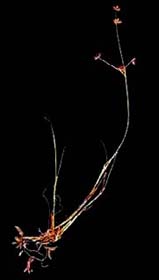| Entorrhizomycetes | |
|---|---|

| |
| Galls on the roots of Juncus articulatus induced by Entorrhiza casparyana | |
| Scientific classification | |
| Domain: | Eukaryota |
| Kingdom: | Fungi |
| Clade: | Symbiomycota |
| Subkingdom: | Dikarya Bauer (2015) [2] |
| Division: | Entorrhizomycota Tedersoo, Sánchez-Ramírez, Kõljalg, Bahram, M. Döring, Schigel, T.W. May, M. Ryberg & Abarenkov (2018) |
| Class: | Entorrhizomycetes Begerow, Stoll & R.Bauer (2007)[1] |
| Type genus | |
| Entorrhiza C.A.Weber (1884)
| |
| Order | |
| Synonyms | |
|
Entorrhizomycetidae Bauer & Oberwinkler 1997[3] | |
Entorrhizomycetes is the sole class in the phylum Entorrhizomycota, within the Fungi subkingdom Dikarya along with Basidiomycota and Ascomycota. It contains three genera and is a small group of teliosporic root parasites that form galls on plants in the Juncaceae (rush) and Cyperaceae (sedge) families. Prior to 2015 this phylum was placed under the subdivision Ustilaginomycotina. A 2015 study[2] did a "comprehensive five-gene analyses" of Entorrhiza and concluded that the former class Entorrhizomycetes is possibly either a close sister group to the rest of Dikarya or Basidiomycota.[4]
- ^ Cite error: The named reference
Begerow 2006was invoked but never defined (see the help page). - ^ a b Cite error: The named reference
Bauer 2015was invoked but never defined (see the help page). - ^ Cite error: The named reference
Bauer 1997was invoked but never defined (see the help page). - ^ "Subphylum Entorrhizomycotina - Hierarchy - The Taxonomicon". taxonomicon.taxonomy.nl. Retrieved 2023-08-21.